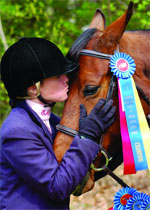In harness racing, a specific breed of horses
called Standardbreds pull a
two-wheeled cart known as
a racebike, which is steered
by a driver. These horses
can reach speeds in excess
of 30 mph.
One thing that makes
harness racing great is that
anyone can get involved.
With a small investment
almost anyone can own a
horse, and there are trainers
and drivers of all different
experience levels. There are
even entire circuits just for
amateur drivers.
But even if you can't afford
to own or train a horse,
you can get up close and
personal with the animals
and drivers at the racetrack.
Many tracks offer barn and
paddock tours and a chance
to meet the horsemen who
compete there.
Although you can watch
harness racing from your
home, on your computer
and even on your phone,
the best way to experience
the sport is live and in
person.
 The Standardbred is a beautiful,
gentle breed of horse that is affectionate
and easy to work with. The
breed comes in many colors, with
bay (a light brown) and
brown being the most
dominant. They
weigh between
800 and 1,200
lbs. and are known
for their willing
temperaments.
The beginnings
of the Standardbred
breed can be traced back
to the horse Messenger, a gray
Thoroughbred who was brought
to the U.S. in the 18th century.
Virtually every North American
Standardbred can be traced back
to Messenger's great-grandson,
Hambletonian 10.
The name "Standardbred"
originated because the early
trotters were required to
reach a certain standard of
time for the mile distance
in order to be registered
as part of the new breed.
Harness racing is based
in tradition and history,
but the Standardbred breed
continues to evolve each year. It's
amazing to watch these incredible
animals reach new levels of speed
and excellence.
The Standardbred is a beautiful,
gentle breed of horse that is affectionate
and easy to work with. The
breed comes in many colors, with
bay (a light brown) and
brown being the most
dominant. They
weigh between
800 and 1,200
lbs. and are known
for their willing
temperaments.
The beginnings
of the Standardbred
breed can be traced back
to the horse Messenger, a gray
Thoroughbred who was brought
to the U.S. in the 18th century.
Virtually every North American
Standardbred can be traced back
to Messenger's great-grandson,
Hambletonian 10.
The name "Standardbred"
originated because the early
trotters were required to
reach a certain standard of
time for the mile distance
in order to be registered
as part of the new breed.
Harness racing is based
in tradition and history,
but the Standardbred breed
continues to evolve each year. It's
amazing to watch these incredible
animals reach new levels of speed
and excellence.
 As a breed, Standardbreds
are athletic,
intelligent and wellsuited
for many different
tasks. After they're done
racing (or perhaps if
they never raced at all),
many Standardbreds go
on to find new homes
and new vocations.
As a breed, Standardbreds
are athletic,
intelligent and wellsuited
for many different
tasks. After they're done
racing (or perhaps if
they never raced at all),
many Standardbreds go
on to find new homes
and new vocations.
Vocations such as police or military mounts, trail-riding companions and outriders are all a good fit for retired Standardbreds.
Many ex-racehorses also have success competing in special disciplines such as dressage, endurance riding, and speed racking. But even if there isn't a new "job" waiting for a horse after he's done racing, the goal is always to find a good, loving home for them, and there are numerous adoption, retirement and pleasure horse organizations committed to doing just that.